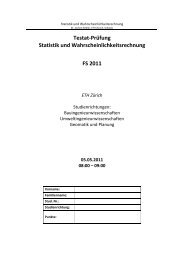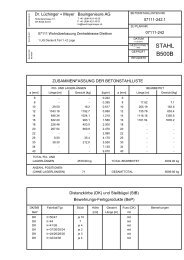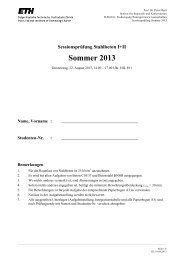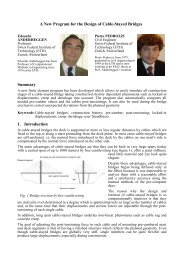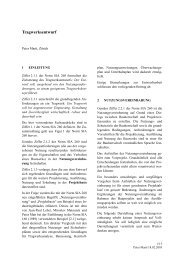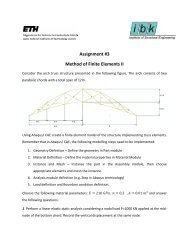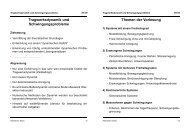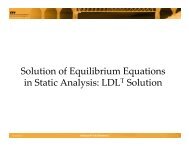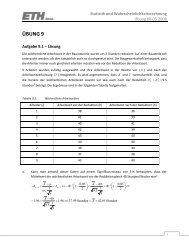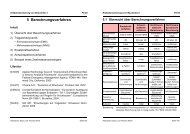IBK Jahresbericht 2004-2006 - Institut für Baustatik und Konstruktion ...
IBK Jahresbericht 2004-2006 - Institut für Baustatik und Konstruktion ...
IBK Jahresbericht 2004-2006 - Institut für Baustatik und Konstruktion ...
Sie wollen auch ein ePaper? Erhöhen Sie die Reichweite Ihrer Titel.
YUMPU macht aus Druck-PDFs automatisch weboptimierte ePaper, die Google liebt.
FORSCHUNG<br />
Erdbebenrisikomanagement unter<br />
Einbeziehung von Zustandsindikatoren<br />
Projektleitung:<br />
Mitarbeitende:<br />
Prof. Dr. M.H. Faber (<strong>IBK</strong>),<br />
Dr. M. Mai (D-ERDW),<br />
Prof. Dr. A. Dazio (<strong>IBK</strong>),<br />
Dr. J. Laue (IGT),<br />
Prof. Dr. H.-R. Schalcher (IBB),<br />
Prof. Dr. A. Grün (IPF)<br />
Dr. J. Baker, Y. Bayraktarli,<br />
J. Buchheister, M. Faizian,<br />
M. Rezaeian, B. Sanli,<br />
Dr. J. Ulfkjaer, U. Yazgan<br />
Projektpartner: Schweizerischer Nationalfonds,<br />
Bern.<br />
Effizientes Management <strong>und</strong> konsistente Quantifizierung<br />
von durch Natur <strong>und</strong> Menschenhand verursachten<br />
Risiken werden zunehmend zum Anliegen<br />
der Gesellschaft. Nachhaltige <strong>und</strong> konsistente Entscheidungsfindung<br />
erfordert einen Rahmen <strong>für</strong> ein<br />
Risikomanagement, das einen Vergleich der Risiken<br />
verschiedener Naturgefahren wie Erdbeben oder<br />
Hochwasser ermöglicht. Die Ergebnisse des Projektes<br />
werden auch <strong>für</strong> andere Arten von Naturrisiken<br />
von Bedeutung sein.<br />
Das Projekt ist in eine integrale interdisziplinäre<br />
<strong>und</strong> eine prozessorientierte Ebene gegliedert. Auf der<br />
integralen Ebene wird das Problem im Rahmen der<br />
Bayes’schen Entscheidungstheorie formuliert, um<br />
eine generische <strong>und</strong> konsistente Basis <strong>für</strong> die Quantifikation<br />
<strong>und</strong> das Management der Risiken zu schaffen.<br />
Die prozessorientierten Teile des Projektes bilden<br />
die Bausteine zum Aufbau des theoretischen<br />
Rahmens des Risikomanagements.<br />
Ein Kernpunkt der Herangehensweise ist die<br />
Quantifizierung der Effekte von verschiedenen Typen<br />
von Informationen auf das Risiko. Diese Indikatoren<br />
können unterschiedliche Merkmale haben <strong>und</strong><br />
erfordern, dass verschiedene Fachkenntnisse ins Projekt<br />
integriert werden. Ein Beispiel <strong>für</strong> solch einen<br />
Indikator ist die Information über die Erdbebennorm,<br />
nach der die Bauwerke bemessen wurden. Zusätzlich<br />
hierzu werden auch <strong>für</strong> Bauwerksschäden bekannte<br />
Indikatoren, wie Verschiebung <strong>und</strong> Rissbildung herangezogen.<br />
Weitere Indikatoren sind die Charakteristiken<br />
des Bodens, die den Energiefluss vom<br />
Festgestein bis zum Baugr<strong>und</strong> bei einem Erdbeben<br />
implizit erfassen. Indikatoren, die das Gelände, die<br />
Bausubstanz <strong>und</strong> die Infrastruktur erfassen, hängen<br />
von der Verfügbarkeit von räumlichen Photogrammetriedaten<br />
ab.<br />
Management of Earthquake Risks Using<br />
Condition Indicators<br />
Efficient management and consistent quantification<br />
of natural and man-made risks is increasingly becoming<br />
an issue of societal concern. Sustainable and<br />
consistent societal decision making requires that a<br />
framework for risk management is developed, allowing<br />
f<strong>und</strong>amental comparisons of risks due to different<br />
natural hazards such as earthquakes, floods<br />
or droughts. The results of this research project will<br />
be of significance for earthquake risk management<br />
and, due to its generic nature, be adaptable to other<br />
types of risks.<br />
The project consists of two levels: an integral,<br />
interdisciplinary level and a process oriented level.<br />
At the integral level, the general problem is formulated<br />
within the framework of the Bayesian decision<br />
theory whereby a generic and consistent basis<br />
for the quantification and management of earthquake<br />
risks will be developed. The process oriented<br />
level aims to establish the building stones required<br />
to develop the risk management framework.<br />
A key element of the pursued approach is the<br />
quantification of the effect of various types of determinable<br />
information (indicators) on the risks. These<br />
indicators may have very different characteristics,<br />
necessitating different expertises to be integrated<br />
into the project. An example of such an indicator is<br />
the information about the structural design codes<br />
applied to the design of structures. In addition,<br />
more traditional indicators in structures, such as<br />
deflections and cracks, will be utilised. Other indicators<br />
are the characteristics of the soil, implicitly<br />
describing the energy transfer due to an earthquake<br />
from the bedrock to the soil surface. Further indicators<br />
are based on the availability of spatial data, describing<br />
the terrain, buildings and traffic networks.<br />
[1] Bayraktarli, Y.Y., Yazgan, U., Dazio, A. and Faber,<br />
M.H. (<strong>2006</strong>). Capabilities of the Bayesian probabilistic<br />
networks approach for earthquake risk management.<br />
Proceedings to the First European Conference on<br />
Earthquake Engineering and Seismology, Geneva,<br />
Switzerland, 3-8 September <strong>2006</strong>, Paper Number: 1458.<br />
30





